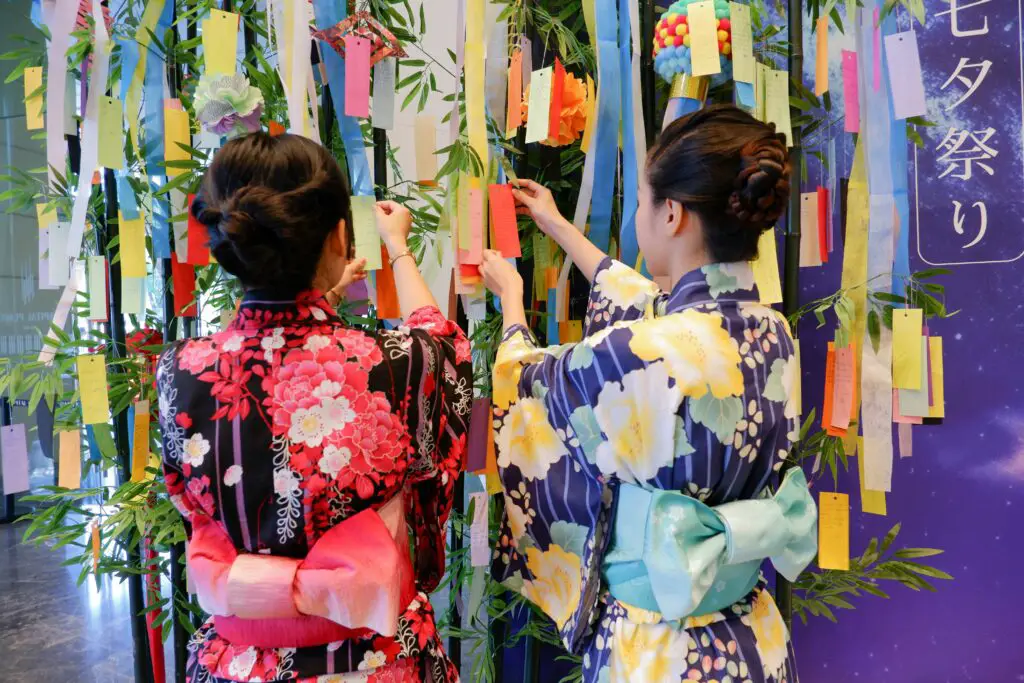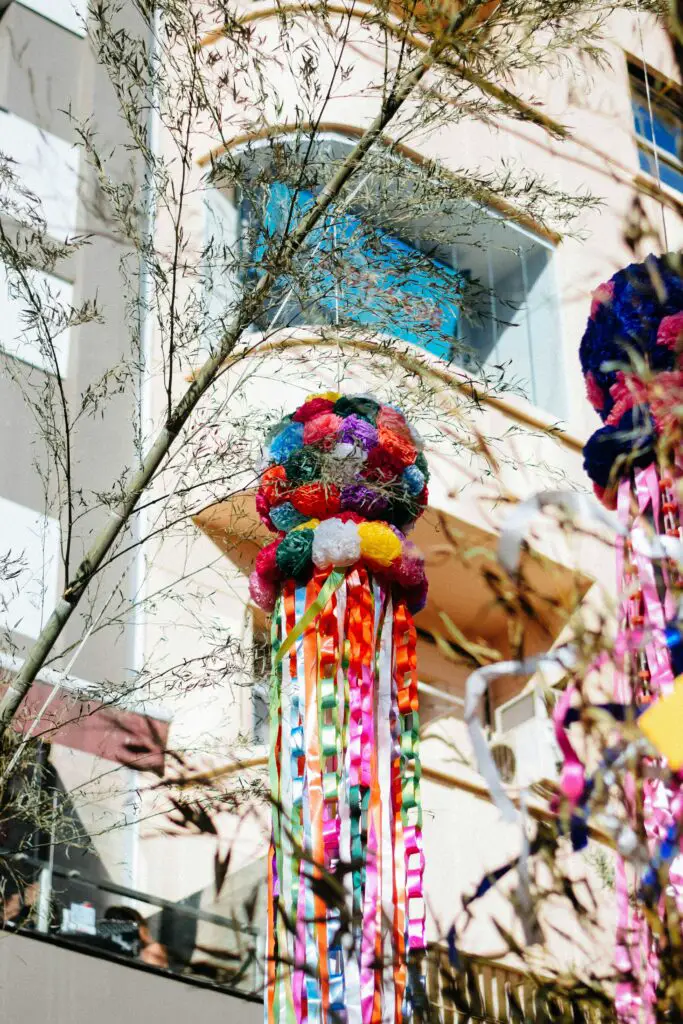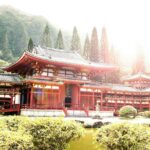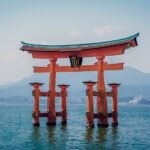Tanabata, a celebrated festival in Japan, captivates the imagination and fills the streets with vibrant colors, enchanting melodies, and joyful festivities.
Originating from a fabled celestial reunion, Tanabata has evolved into a cherished event that encourages communities to come alive with creativity and community spirit.
In this article, we will delve into the captivating world of Tanabata, exploring its origins, rituals, and the deeply ingrained significance it holds for the people of Japan.
Key Takeaways
- Tanabata is a traditional Japanese festival that celebrates the meeting of two celestial lovers, Orihime and Hikoboshi. This festival has a rich history and is filled with various customs and traditions.
- According to legend, Orihime, a weaver princess, and Hikoboshi, a cow herder, were separated by the gods due to neglecting their duties. They could only reunite once a year on the seventh day of the seventh lunar month.
- During Tanabata, people celebrate this celestial reunion by writing their wishes on colorful strips of paper called tanzaku. These wishes are then hung on bamboo branches.
- The streets and shopping districts are adorned with beautiful and vibrant decorations, including large paper lanterns, streamers, and handmade ornaments.
- Tanabata is a time for communities to come together and celebrate. Festivals are held throughout Japan, featuring lively parades, traditional music and dance performances, and delicious food stalls. People of all ages join in the festivities, wearing traditional yukata robes and enjoying the festive atmosphere.
What is Tanabata (Star Festival)?
Tanabata (“たなばた or 七夕,” meaning “Evening of the 7th”), also known as the Star Festival (星祭り, Hoshi matsuri), is a traditional festival celebrated in Japan on the 7th day of the 7th month (July 7th).
This festival is also known as the star festival because it’s believed that on this day, two stars named Altair and Vega meet.
Altair is represented by the star Hikoboshi, while Vega is represented by the star Orihime. Legend has it that these two stars are separated by the Milky Way and can only reunite on this special day. We’ll discuss more about this myth later on.
The festival is filled with hope and romance, symbolizing the annual reunion of Orihime and Hikoboshi, represented by the stars Vega and Altair.
Tanabata is a celebration that brings communities together and allows individuals to express their desires and aspirations. It’s a time for reflection, celebration, and the sharing of dreams.
The Myth Behind Tanabata: Orihime and Hikoboshi
The Tanabata festival is a captivating celebration that has its roots in a beautiful myth.

It tells the story of Orihime (Vega), a talented seamstress who lived near the heavenly river, represented by the Milky Way, and her lover Hikoboshi (Altair).
Orihime spent her days tirelessly weaving exquisite clothes, but she longed for love. Her father, a god of the heavens, arranged for her to meet Hikoboshi, a cow herder on the other side of the Milky Way. When they met, they instantly fell in love and got married.
So profound was their devotion that Orihime abandoned her weaving, and Hikoboshi allowed his cows to roam freely through the heavens.
The lovers’ brazen disobedience to their responsibilities angered Orihime’s father, and he forbade them from being together.
However, the determined princess pleaded passionately, tugging at her father’s heartstrings. Moved by his daughter’s love, he issued a decree: the star-crossed couple could reunite only once a year, solely on the 7th day of the 7th month, on the condition that Orihime must continue her weaving.
On the first day of their reunion, the lovers found the Milky Way’s vastness too difficult to cross. Overwhelmed with despair, Orihime sank into sorrow. Yet, in a remarkable turn of events, a flock of magpies gracefully descended, uniting their wings to form a bridge for her across the heavenly river.
Legend holds that unless the weather remains clear on Tanabata, the day of the lovers’ long-awaited reunion, the magpies will not appear, forcing the lovers to yearn for one another for yet another year.
Because of this, the people of Japan always hope for good weather on this happy day. This story has been told in different ways, but this version is the one most people agree on.

History of the Tanabata Festival
Tanabata is a festival that has been around for a very long time. The festival originally comes from a Chinese event called Qixi, and the story of Tanabata can be traced back to a Chinese legend about the Weaver and the Cowherd.
Empress Koken brought it to Japan in the year 755. The festival was adopted during the Heian period and was initially celebrated in the Kyoto Imperial Court under the name “The Festival to Plead for Skills” or Kikkōden (乞巧奠, Kikkōden), an alternative name for Qixi.
This festival takes place on the seventh day of the seventh month in the lunar calendar, which usually falls in July.
Over time, the festival became more popular among the general public during the early Edo period. It merged with various Obon or Bon traditions, as Bon was traditionally held on the 15th of the seventh month in Japan. This combination led to the development of the modern Tanabata festival.
The history of Tanabata is a captivating mix of ancient court traditions and folklore. It has evolved over time, but its essence remains the same – a celebration of love and the belief in the power of wishes. Today, Tanabata is celebrated by people of all ages, creating a sense of unity and joy in communities across Japan.
Practices in Tanabata
The Tanabata festival is a celebration where people engage in various practices to symbolize their wishes and blessings.
Tanzaku

One popular tradition of Tanabata is hanging colored paper strips called Tanzaku (短冊) on trees or bamboo stalks.
People write their wishes on these tanzaku, and it’s believed that hanging them on the evening of July 7th will make those wishes come true.
During Tanabata, you might also see colorful streamers that are hung from storefronts and telephone poles. There are also a lot of smaller decorations like the ones you might see in some temples and shrines.
Origami
Another practice during Tanabata involves making origami decorations of cranes, which symbolize prayers for a long life. People also create ornamental decorations that represent good business, good fishing, cleanliness, and improved weaving skills.
Traditional foods
Tanabata festival often offers a variety of traditional Japanese foods and sweets. People can indulge in delicious treats like takoyaki (たこ焼き – octopus balls), yakisoba (焼きそば – fried noodles), taiyaki (たい焼きfish-shaped pancake with sweet fillings), and matcha-flavored snacks.
Kakigōri (かき氷) is also a popular treat enjoyed during Tanabata festivals and the summer season in general. Kakigōri is a traditional Japanese shaved ice dessert that is flavored with various syrups.
It is typically served in a bowl or cup and topped with colorful sweet toppings like condensed milk, fruits, sweetened red bean paste, and mochi.
Fireworks
In many locations, Tanabata festivities are concluded with spectacular fireworks displays. People gather to watch the colorful fireworks illuminate the night sky, adding a sense of grandeur and excitement to the celebration.
Popular Sites For Attending Tanabata Festival

Festivities in Japan often feature grand decoration competitions, traditional games, and street food stalls, and Tanabata is no exception.
Let’s take a glimpse at some of the prominent Tanabata celebrations taking place all across Japan.
Sendai Tanabata Festival, Miyagi (August 6 – 8)
The Sendai Tanabata Festival in Miyagi is the largest and most popular Tanabata festival in Japan. It has a rich history dating back to feudal times and regained popularity after World War 2.
The festival is known for its beautiful decorations, numerous food stalls, and exciting fireworks on the evening of August 5th.
Asagaya Tanabata Festival, Tokyo (Early August)
The Asagaya Tanabata Festival in Tokyo is held in early August and is also a popular site for celebrating Tanabata. Asagaya is a local area within the bustling city, providing a unique and interesting atmosphere.
During the festival, the entire shopping area is adorned with colorful decorations, creating a lively and festive ambiance. In the evening, visitors can enjoy the various food stalls and experience the vibrant energy of the locals.
Hiratsuka Tanabata Festival, Kanagawa (July 7 – 9)
The Hiratsuka Tanabata Festival in Kanagawa is the largest Tanabata festival in the Tokyo area. It takes place on the north side of Hiratsuka station over three consecutive evenings in early July.
The festival is known for its vibrant and colorful streamers, numbering around 500 in total, creating a stunning spectacle. One of the main highlights is the lively dance parade that adds to the festive atmosphere.
Conclusion
Tanabata is a time for communities to come together and celebrate. Festivals are held throughout Japan, featuring lively parades, traditional music and dance performances, and delicious food stalls.
People of all ages join in the festivities, wearing traditional yukata robes and enjoying the festive atmosphere.
So, why not immerse yourself in the magical world of Tanabata? Experience the joy of writing your wishes and witnessing the streets come alive with colorful decorations.
Join the celebrations and be part of this enchanting festival that commemorates the love story of Orihime and Hikoboshi, the celestial lovers who meet once a year in the starry sky.









